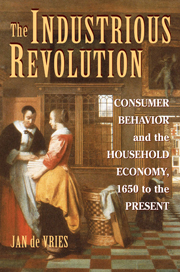Book contents
- Frontmatter
- Contents
- List of Figures
- Preface and Acknowledgments
- 1 The Transformation of Consumer Desire in the Long Eighteenth Century
- 2 The Origins of the Industrious Revolution
- 3 The Industrious Revolution: The Supply of Labor
- 4 The Industrious Revolution: Consumer Demand
- 5 The Breadwinner–Homemaker Household
- 6 A Second Industrious Revolution?
- Bibliography
- Index
4 - The Industrious Revolution: Consumer Demand
Published online by Cambridge University Press: 05 June 2012
- Frontmatter
- Contents
- List of Figures
- Preface and Acknowledgments
- 1 The Transformation of Consumer Desire in the Long Eighteenth Century
- 2 The Origins of the Industrious Revolution
- 3 The Industrious Revolution: The Supply of Labor
- 4 The Industrious Revolution: Consumer Demand
- 5 The Breadwinner–Homemaker Household
- 6 A Second Industrious Revolution?
- Bibliography
- Index
Summary
The previous chapter explored the paths by which households became more industrious in the course of the long eighteenth century, devoting more of their labor to market-oriented activities. The concept at this study's core argues that this new industriousness was substantially motivated by new consumer aspirations. Is it possible to observe consumer behavior consistent with the industrious revolution hypothesis?
First a word is necessary about what we are not looking for. The new consumer demand was not a “consumer revolution,” an exploding volume of purchased goods that jump-started the growth of production in the “leading sectors” of the Industrial Revolution. Indeed, it is striking how little the expansion of industrial production and the unfolding of consumer demand touch each other directly until the twentieth century. Nor was the new consumer demand driven primarily by emulation, where rising incomes allowed progressively lower socioeconomic strata to adopt, and be incorporated into, the material world of their social superiors.
Rather, the consumer demand of this era was associated with a broadened choice in the selection of “consumer technologies” whereby the ultimately consumed “Z-commodities” sought by various socioeconomic groups could be produced. An increased substitutability between the goods and the time inputs in consumption made possible substantial redistributions of the productive resources of the household at the same time as it encouraged renegotiation of the distribution of consumption resources within the household. That is, consumer demand developed through an interaction of market and household productive systems.
- Type
- Chapter
- Information
- The Industrious RevolutionConsumer Behavior and the Household Economy, 1650 to the Present, pp. 122 - 185Publisher: Cambridge University PressPrint publication year: 2008



